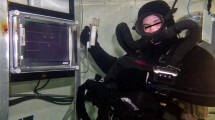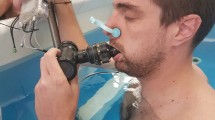Abstract
Diving negatively affects the human respiratory system, especially if an oxygen breathing apparatus is used. The spirometry indices generally used to estimate the ventilatory function of the lung have a poor sensitivity to the toxic effect of hyperbaric hyperoxia. The goal of this study was to estimate the possibilities of using the forced expiratory (FE) tracheal noise duration. The study was done on 48 divers who had been tested before and after a single dive.
A significant decrease in the spirography volumes but within normal limits was seen totally in the group. In analyzing individual responses, a significant increase in the FE tracheal noise duration above the normal range (19.6%, p < 0.05) was found in ten subjects (20.8%). Respiratory symptoms that were typical of the initial manifestations of pulmonary oxygen intoxication were found in three cases in these subjects. In the remaining seven subjects, the asymptomatic increase in the FE tracheal noise duration was classified as a sign of the latent preclinical phase of the hyperbaric hyperoxia effect.
Similar content being viewed by others
References
Cotes, J.E., Davey, I.S., Reed, J.W., and Rooks, M., Respiratory Effects of a Single Saturation Dive to 300 m, Br. J. Ind. Med, 1987, vol. 44, p. 76.
Thorsen, E., Segadal, K., Myrseth, E., Pasche, A., and Gulsvik, A., Pulmonary Mechanical Function and Diffusion Capacity after Deep Saturation Dives, Br. J. Ind. Med., 1990, vol. 47, p. 242.
Thorsen, E., Segadal, K., and Kambestad, B.K., Mechanisms for Reduced Pulmonary Function after a Saturation Dive, Eur. Respir. J., 1994, vol. 4, p. 4.
Skogstad, M., Thorsen, E., Haldorsen, T., et al., Divers’ Pulmonary Function after Open-Sea Bounce Dives to 10 and 50 Meters, Undersea Hyperb. Med., 1996, vol. 23, p. 71.
Neubauer, B. and Tetzlaff, K., Prospective Lung Function Determination Using an Electronic Miniature Spirometer for Detection of Acute Obstructive Respiratory Changes in Diving Students during Occupational Diving Training, Pneumologie, 1999, vol. 53, p. 219.
Clark, J.M., Lambertsen, C.J., Gelfand, R., et al., Effects of Prolonged Oxygen Exposure at 1.5, 2.0, or 2.5 ATA on Pulmonary Function in Men (Predictive Studies V), J. Appl. Physiol., 1999, vol. 86, p. 243.
Thorsen, E., Stgadal, K., Reed, J.W., et al., Contribution of Hyperoxia to Reduced Pulmonary Function after Deep Saturation, J. Appl. Physiol., 1993, vol. 75, p. 657.
Smolin, V.V., Sokolov, G.M., and Pavlov, B.N., Vodolaznye spuski i ikh meditsinskoe obespechenie (Dives and Their Medical Support), Moscow: Slovo, 2001.
Shykoff, B., Pulmonary Effects of Submerged Oxygen Breathing: 4-, 6-, and 8-Hour Dives at 140 KPa, Undersea Hyperb. Med., 2005, vol. 32, no. 5, pp. 351–361.
Pochekutova, I.A., Korenbaum, V.I., Kulakov, Yu.V., Avdeeva, E.V., and Tagil’tsev, A.A., Significance of Spectral and Time Parameters of Forced Expiratory Sound in Evaluating Bronchial Patency, Fiziol. Chel., 2001, vol. 27, no. 4, p. 441 [Human Physiol. (Engl. Transl.), 2001, vol. 27, no. 4, p. 441].
Pochekutova, I.A. and Korenbaum, V.I., Duration of Tracheal Sound Recorded during Forced Expiration: From a Model to Establishing Standards, Fiziol. Chel., 2007, vol. 33, no. 1, p. 70 [Human Physiol. (Engl. Transl.), 2007, vol. 33, no. 1, p. 59].
Pochekutova, I.A., Korenbaum, V.I., and Agapov, Ya.V., Acoustic and spirometric indices of external respiration function in divers using the oxygen closed type breathing apparatus, Voenno-Med. Zh. 2006, vol. 327, p. 58.
Korenbaum, V.I. and Pochekutova, I.A., Regression Simulation of the Dependence of Forced Expiratory Tracheal Noises Duration on Human Respiratory System Biomechanical Parameters, J. Biomechanics, 2008, vol. 41, p. 63.
Korenbaum, V.I., Tagil’tsev, A.A., Kostiv, A.E., et al., Acoustic Equipment for Measuring Human Breath Noises, Prib. Tekh. Eksp., 2008, vol. 51, p. 143.
Quanjer, Ph.H., Tammeling, G.J., Cotes, J.E., et al., Lung Volumes and Forced Ventilatory Flows: Report Working Party Standardization of Lung Function Tests, European Community for Steel and Coal: Official Statement of the European Respiratory Society, Eur. Respir. J., 1993, vol. 6,suppl. 16, p. 5.
Mussell, M.J., Nakazono, Y., and Miyamoto, Y., Effect of Air Flow and Flow Transducer on Tracheal Breath Sounds, Med. Biol. Eng. Comput., 1990, vol. 28, p. 550.
Belovol, E.V., Pochekutova, I.A., and Korenbaum, V.I., Short-Term Reproducibility of the Forced Expiratory Tracheal Noises, in Sbornik trudov XVIII sessii Rossiiskogo akusticheskogo obshchestva (Proc. XVIII Session of Russian Acoustic Society), Moscow: GEOS, 2006.
Reed, J.W., Elliott, C., and Thorsen, E., Increased Lung Compliance in Response to a Moderate Hyperoxic Exposure, Undersea Hyperb. Med., 2001, vol. 28, p. 19.
Bearden, S.E., Cheuvront, S.N., Ring, T.A., and Haymes, E.M., Oxidative Stress During a 3.5-Hour Exposure to 120 kPa(A) PO2 in Human Divers, Undersea Hyperb. Med., 1999, vol. 26, p. 159.
Neubauer, B., Schotte, U., and Struck, N., et al., Leukotriene-B4 Concentrations in Breathing Condensate before and after Simulated Deep Dives, Undersea Hyperb. Med., 2004, vol. 31, p. 217.
Carpagnano, G.E., Kharitonov, S.A., Foschino-Barbaro, M.P., et al., Supplementary Oxygen in Healthy Subjects and Those with COPD Increases Oxidative Stress and Airway Inflammation, Thorax, 2004, vol. 59, p. 1016.
Neubauer, B., Mutzbauer, T.S., and Tetzlaff, K., Exposure to Soda-Lime Dust in Closed and Semi-Closed Diving Apparatus, Aviat. Space. Environ. Med., 2000, vol. 71, p. 1248.
Korenbaum, V.I. and Pochekutova, I.A., Analysis of the Human Forced Expiratory Tracheal Noises According to Clinical Experimental Data, Akust. Zh., 2004, vol. 50, p. 676.
Burger, E.J. and Mead, J., Static Properties of Lungs after Oxygen Exposure, J. Appl. Physiol., 1969, vol. 27, p. 191.
Author information
Authors and Affiliations
Additional information
Original Russian Text © I.A. Pochekutova, V.I. Korenbaum, 2011, published in Fiziologiya Cheloveka, 2011, Vol. 37, No. 3, pp. 76–82.
Rights and permissions
About this article
Cite this article
Pochekutova, I.A., Korenbaum, V.I. Acoustic estimation of the impact of a single dive using a closed-type breathing apparatus on the ventilatory function of the human lungs. Hum Physiol 37, 334–338 (2011). https://doi.org/10.1134/S0362119711020162
Received:
Published:
Issue Date:
DOI: https://doi.org/10.1134/S0362119711020162




